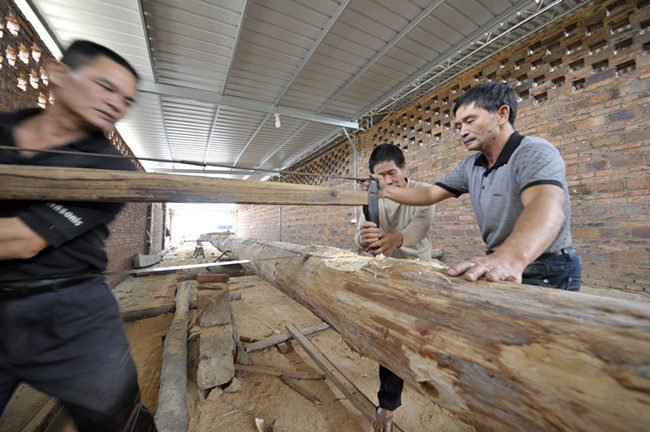An inheritor of ancient boat making techniques
By Xu Lin and Hu Meidong ( China Daily ) Updated: 2015-06-20 09:04:01
 |
|
Zheng Shuitu (right) saws wood with workers.[Photo by Lin Ruihong/China Daily] |
Located at Haicheng town, Longhai city, the port of Yuegang looks much similar to any quiet small village along the coastline. But some cargo ships in the river serve as a reminder of its glorious history as a major commercial port of Fujian during the mid-and late Ming Dynasty (1368-1644).
At that time, Yuegang had direct trade contacts with 47 countries and regions such as Southeast Asia, Japan and Korea. There is no doubt that the traditional wooden boat making industry was booming in the area.
Zheng Shuitu, 58, the inheritor of the old boat building techniques, is in charge of Zongxing Shipyard near the port, which has a history of more than 100 years. His family started to make wooden sailing vessels as early as the Ming Dynasty. Until the 1910s, these sailing ships would travel to domestic and overseas ports including Singapore and the Philippines.
Since about 30 years ago, he has been mainly building dragon boats to maintain the shipyard because wooden ships do not have governmental permit to sail in the sea. The number of orders is about 30 to 40 a year on average, and will increase if the government organizes dragon boat races. He also makes beautiful sailing vessel models.
"I have to carry on the ancestral techniques. Buyers love my dragon boats because they are fast," he says. He started to make boats at the age of 14.
"I don't need a drawing sheet. All the things are in my head."
The traditional dragon boats are about 18-meter-long, but he is making even longer ones. He often uses tens of thousands of nails cast from pig irons with the length of 8 to 12 centimeters to connect the boat body. He then smears a mixture of tung oil and pounded oyster shells for grouting, to prevent water from seeping in.
|
|
|
|
|
|
|
|

























 Raymond Zhou:
Raymond Zhou: Pauline D Loh:
Pauline D Loh: Hot Pot
Hot Pot Eco China
Eco China China Dream
China Dream China Face
China Face






